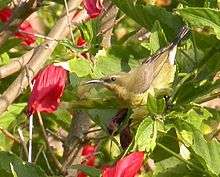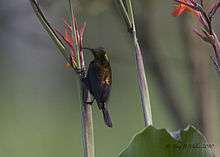Copper sunbird
The copper sunbird (Cinnyris cupreus) is a species of passerine bird in the family Nectariniidae. It is native to tropical Africa, its range extending from Senegal and Guinea in the west to South Sudan and Kenya in the east, and southwards to Angola, Zambia, Zimbabwe and Mozambique.
| Copper sunbird | |
|---|---|
 | |
| Female | |
| Scientific classification | |
| Kingdom: | Animalia |
| Phylum: | Chordata |
| Class: | Aves |
| Order: | Passeriformes |
| Family: | Nectariniidae |
| Genus: | Cinnyris |
| Species: | C. cupreus |
| Binomial name | |
| Cinnyris cupreus (Shaw, 1812) | |
| Synonyms | |
|
Nectarinia cuprea | |
Description

The adult male copper sunbird is about 12.5 cm (5 in) long. The subspecies C. c. cupreus inhabits the western part of its range and weighs about 7.5 to 11 g (0.26 to 0.39 oz). The male C. c. chalceus, from the eastern half, weighs 7.5 to 11 g (0.26 to 0.39 oz) while the female of both subspecies weighs 7.3 to 10.2 g (0.26 to 0.36 oz).[2]
Distribution and habitat
It is found in Angola, Benin, Botswana, Burkina Faso, Burundi, Cameroon, Central African Republic, Chad, Republic of the Congo, Democratic Republic of the Congo, Ivory Coast, Ethiopia, Gabon, Gambia, Ghana, Guinea, Guinea-Bissau, Kenya, Liberia, Malawi, Mali, Mauritania, Mozambique, Namibia, Niger, Nigeria, Rwanda, Senegal, Sierra Leone, South Africa, Sudan, Tanzania, Togo, Uganda, Zambia, and Zimbabwe. It is a non-migratory bird and is resident across its range.[1] Its habitat is mainly savannas, but also includes degraded forest, woodland, marshes, mangroves, coastal thickets and agricultural land.[2]
Ecology
The copper sunbird feeds on nectar that it sipps from selected flowers. Some of its favourite trees and plants include Calliandra spp., Leonotis leonurus, Syzygium spp., and Senegalia polyacantha. It also takes fruits, spiders and insects, some of which are caught on the wing.[3]
Status
The copper sunbird has a wide range and a large total population. It is a common bird and the International Union for Conservation of Nature has assessed its conservation status as being of "least concern".[1]
References
- BirdLife International (2012). "Nectarinia cuprea". IUCN Red List of Threatened Species. 2012. Retrieved 19 October 2016.CS1 maint: ref=harv (link)
- Fry, H.; Kirwan, G.M. (2016). "Abyssinian Roller (Coracias abyssinicus)". Handbook of the Birds of the World Alive. Lynx Edicions, Barcelona. Retrieved 19 October 2016.
- "Coppery sunbird" (PDF). The Atlas of Southern African Birds. Retrieved 19 October 2016.
